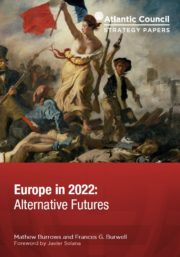
Europe in 2022: Alternative Futures

Executive Summary
Sixty years after the signing of the Treaty of Rome, Europe faces its greatest challenges, and possibly its sharpest turning point, since World War II. The spectrum of possible futures for Europe is wide, encompassing everything from rebirth to disintegration. But, a strong leap toward greater EU-wide integration—as was sometimes the outcome of earlier crises—seems unlikely at best. Instead, this seems a time for smaller steps toward more integration, most likely in response to specific challenges, including: stronger external border controls; enhanced eurozone governance; or a more capable Common Security and Defense Policy. If the positive option is modest integration, the alternative future is one dominated by a clear break with past integration. A presidential victory in May by France’s Marine Le Pen could splinter the European Union, sending it into a tailspin toward disintegration. Even if this dire forecast is avoided, Europe—and especially the European Union (EU)—will face challenges that push it into entirely new directions. If the United States withdraws from Europe, for example, will Europe be forced to accommodate Russian demands? Or will that challenge foster stronger security cooperation among a core set of nations, to counterbalance a weakening NATO? And if Europe’s economy continues on a slow-growth path, will it be able to afford to respond to the challenges it faces?
- Issues:
- Economics, Global and Domestic Governance
- Region:
- Europe
- Year Published:
- 2017
- Authors:
- Mathew J. Burrows, Frances G. Burwell
- Institution:
- Atlantic Council

